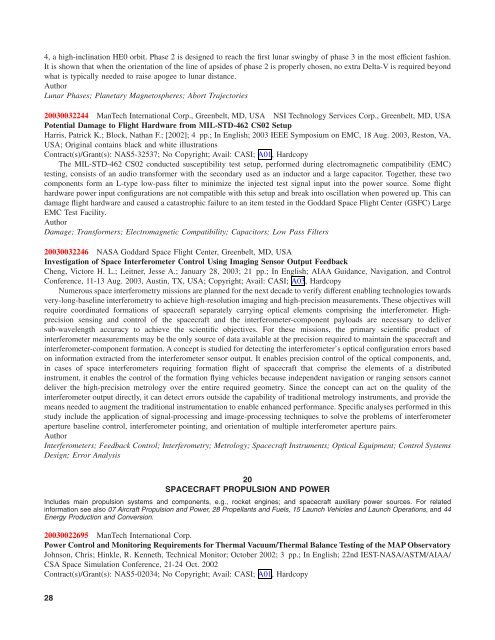You also want an ePaper? Increase the reach of your titles
YUMPU automatically turns print PDFs into web optimized ePapers that Google loves.
4, a high-inclination HE0 orbit. Phase 2 is designed to reach the first lunar swingby of phase 3 in the most efficient fashion.<br />
It is shown that when the orientation of the line of apsides of phase 2 is properly chosen, no extra Delta-V is required beyond<br />
what is typically needed to raise apogee to lunar distance.<br />
Author<br />
Lunar Phases; Planetary Magnetospheres; Abort Trajectories<br />
20030032244 ManTech International Corp., Greenbelt, MD, USA NSI Technology Services Corp., Greenbelt, MD, USA<br />
Potential Damage to Flight Hardware from MIL-STD-462 CS02 Setup<br />
Harris, Patrick K.; Block, Nathan F.; [2002]; 4 pp.; In English; 2003 IEEE Symposium on EMC, 18 Aug. 2003, Reston, VA,<br />
USA; Original contains black and white illustrations<br />
Contract(s)/Grant(s): NAS5-32537; No Copyright; Avail: CASI; A01, Hardcopy<br />
The MIL-STD-462 CS02 conducted susceptibility test setup, performed during electromagnetic compatibility (EMC)<br />
testing, consists of an audio transformer with the secondary used as an inductor and a large capacitor. Together, these two<br />
components form an L-type low-pass filter to minimize the injected test signal input into the power source. Some flight<br />
hardware power input configurations are not compatible with this setup and break into oscillation when powered up. This can<br />
damage flight hardware and caused a catastrophic failure to an item tested in the Goddard Space Flight Center (GSFC) Large<br />
EMC Test Facility.<br />
Author<br />
Damage; Transformers; Electromagnetic Compatibility; Capacitors; Low Pass Filters<br />
20030032246 NASA Goddard Space Flight Center, Greenbelt, MD, USA<br />
Investigation of Space Interferometer Control Using Imaging Sensor Output Feedback<br />
Cheng, Victore H. L.; Leitner, Jesse A.; January 28, 2003; 21 pp.; In English; AIAA Guidance, Navigation, and Control<br />
Conference, 11-13 Aug. 2003, Austin, TX, USA; Copyright; Avail: CASI; A03, Hardcopy<br />
Numerous space interferometry missions are planned for the next decade to verify different enabling technologies towards<br />
very-long-baseline interferometry to achieve high-resolution imaging and high-precision measurements. These objectives will<br />
require coordinated formations of spacecraft separately carrying optical elements comprising the interferometer. Highprecision<br />
sensing and control of the spacecraft and the interferometer-component payloads are necessary to deliver<br />
sub-wavelength accuracy to achieve the scientific objectives. For these missions, the primary scientific product of<br />
interferometer measurements may be the only source of data available at the precision required to maintain the spacecraft and<br />
interferometer-component formation. A concept is studied for detecting the interferometer’s optical configuration errors based<br />
on information extracted from the interferometer sensor output. It enables precision control of the optical components, and,<br />
in cases of space interferometers requiring formation flight of spacecraft that comprise the elements of a distributed<br />
instrument, it enables the control of the formation flying vehicles because independent navigation or ranging sensors cannot<br />
deliver the high-precision metrology over the entire required geometry. Since the concept can act on the quality of the<br />
interferometer output directly, it can detect errors outside the capability of traditional metrology instruments, and provide the<br />
means needed to augment the traditional instrumentation to enable enhanced performance. Specific analyses performed in this<br />
study include the application of signal-processing and image-processing techniques to solve the problems of interferometer<br />
aperture baseline control, interferometer pointing, and orientation of multiple interferometer aperture pairs.<br />
Author<br />
Interferometers; Feedback Control; Interferometry; Metrology; Spacecraft Instruments; Optical Equipment; Control Systems<br />
Design; Error Analysis<br />
20<br />
SPACECRAFT PROPULSION AND POWER<br />
Includes main propulsion systems and components, e.g., rocket engines; and spacecraft auxiliary power sources. For related<br />
information see also 07 Aircraft Propulsion and Power, 28 Propellants and Fuels, 15 Launch Vehicles and Launch Operations, and 44<br />
Energy Production and Conversion.<br />
20030022695 ManTech International Corp.<br />
Power Control and Monitoring Requirements for Thermal Vacuum/Thermal Balance Testing of the MAP Observatory<br />
Johnson, Chris; Hinkle, R. Kenneth, Technical Monitor; October 2002; 3 pp.; In English; 22nd IEST-NASA/ASTM/AIAA/<br />
CSA Space Simulation Conference, 21-24 Oct. 2002<br />
Contract(s)/Grant(s): NAS5-02034; No Copyright; Avail: CASI; A01, Hardcopy<br />
28
















